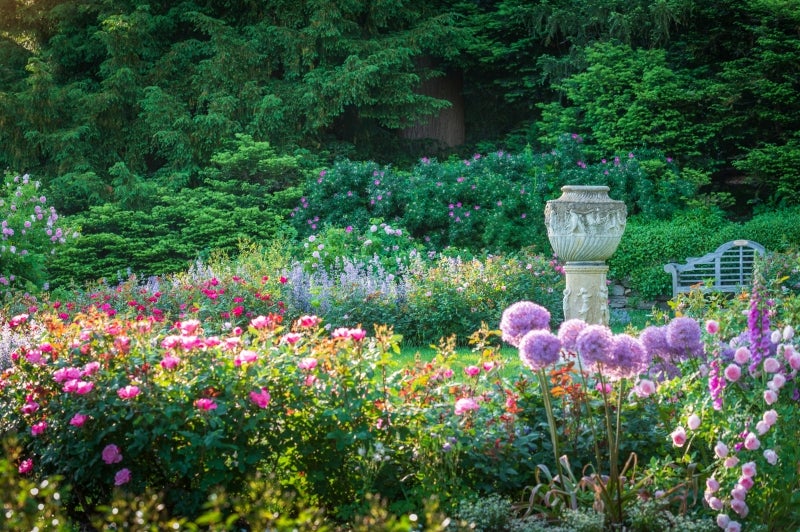Signature Gardens

Rose Garden

The Rose Garden was created in 1888 and is one of the oldest features of the Morris estate. Originally comprised of fruits, vegetables, flowers, a few roses, and a specimen chestnut tree, Lydia Morris transformed this mixed garden into a Rose Garden in 1924.
Once a monoculture of roses, today the Rose Garden contains a mix of roses, perennials, annuals and woody plants with height elements and garden ornaments added to create a look reminiscent of the Victorian era.
English Park

John Morris created the English Park around 1912, filling it mainly with plants from China. In keeping with English tradition, the area provides light and open vistas of the surrounding landscape. Today, the English Park is marked by gently rolling lawns bordered by significant collections of maples, witchhazels, dogwoods, cherries, and stewartias.
One of the most noticeable features of the English Park which remains today is the Step Fountain. The fountain was commissioned by Lydia Morris in 1916 in honor of her brother John who had died shortly before. In 1988, the Step Fountain underwent a restoration and the sculpture “After B.K.S. Iyengar” was installed.
Rock Wall Garden
The Rock Wall Garden was built in 1924, about the same time the area was changed into a Rose Garden. The six-foot-high wall is made of Wissahickon schist, and is filled with a variety of perennials. It is a sunny, south-facing location, with well-drained, cool cracks, providing conditions similar to those in alpine regions. Plants with short stems, dense, tough or hairy foliage and those with long fibrous roots or taproots grow well in this environment. The wall provides a unique display for colorful cascading plants in early spring.
The Alice & J. Liddon Pennock Flower Walk
A garden of vibrant color and texture, the Alice and J. Liddon Pennock Flower Walk represents the realization of a dream envisioned by plantsman, philanthropist and longtime Morris friend, Liddon Pennock. Liddon, who passed away in 2003, first proposed the idea of a new garden at the Morris in the 1990s, when he served on the Advisory Board of Managers. He was eager to see more color at the Morris and wanted to help create a teaching garden that would serve as a living laboratory where interns, students and the general public could learn about plant life. Liddon ensured that his dream would become reality through a generous bequest, which provided for the design and implementation of the new garden, and provided funds for a designated endowment to support an internship and ongoing maintenance of the garden.
Fortunately, Liddon was able to have a hand in the design of this garden while he was still active at the Morris. He very much wanted it to be a garden of splendor, and in keeping with his wishes, the garden was designed to incorporate brilliant color through a combination of woody plants, perennials and non-hardy plants. While it is located on a site where the Morrises once had an elaborate double flower border, the new area is contemporary in design and planting. The palette features sunset colors in shades of orange, red, chartreuse and purple, with touches of silver.
Nestled among towering trees, many of which date to the Morrises’ time, it provides the perfect backdrop to showcase plants that have been wild-collected from various Morris plant explorations around the world. Among the many plants, visitors will find morning calm Chinese trumpet creeper (Campsis grandiflora), and blue stars (Amsonia tabernaemontana), just to name a few.
The placement of the Pennock garden restores the central axis of the flower garden that was created by the Morrises for their estate. A wonderful addition to the landscape, this spectacular garden also serves as a lasting memorial to Liddon and Alice Pennock, and honors their many contributions to the Morris.